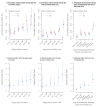Early chains of transmission of COVID-19 in France, January to March 2020
- PMID: 35144724
- PMCID: PMC8832523
- DOI: 10.2807/1560-7917.ES.2022.27.6.2001953
Early chains of transmission of COVID-19 in France, January to March 2020
Abstract
IntroductionSARS-CoV-2, the virus that causes COVID-19, has spread rapidly worldwide. In January 2020, a surveillance system was implemented in France for early detection of cases and their contacts to help limit secondary transmissions.AimTo use contact-tracing data collected during the initial phase of the COVID-19 pandemic to better characterise SARS-CoV-2 transmission.MethodsWe analysed data collected during contact tracing and retrospective epidemiological investigations in France from 24 January to 30 March 2020. We assessed the secondary clinical attack rate and characterised the risk of a contact becoming a case. We described chains of transmission and estimated key parameters of spread.ResultsDuring the study period, 6,082 contacts of 735 confirmed cases were traced. The overall secondary clinical attack rate was 4.1% (95% confidence interval (CI): 3.6-4.6), increasing with age of index case and contact. Compared with co-workers/friends, family contacts were at higher risk of becoming cases (adjusted odds ratio (AOR): 2.1, 95% CI: 1.4-3.0) and nosocomial contacts were at lower risk (AOR: 0.3, 95% CI: 0.1-0.7). Of 328 infector/infectee pairs, 49% were family members. The distribution of secondary cases was highly over-dispersed: 80% of secondary cases were caused by 10% of cases. The mean serial interval was 5.1 days (interquartile range (IQR): 2-8 days) in contact tracing pairs, where late transmission events may be censored, and 6.8 (3-8) days in pairs investigated retrospectively.ConclusionThis study increases knowledge of SARS-CoV-2 transmission, including the importance of superspreading events during the onset of the pandemic.
Keywords: SARS-CoV-2; cluster; contact tracing; secondary clinical attack rate; superspreading; transmission.
Conflict of interest statement
Figures





References
-
- AFP-Agence France Presse. Coronavirus: 4.5 Billion People Confined. Barron's: New Jersey; 17 Apr 2020. Available from: https://www.barrons.com/news/coronavirus-4-5-billion-people-confined-015...
-
- Santé publique France. COVID-19 - Point épidémiologique hebdomadaire du 13 mai 2021. [COVID-19 weekly epidemiological report]. Saint-Maurice: Santé publique France. 13 May 2021. French. Available from: https://www.santepubliquefrance.fr/maladies-et-traumatismes/maladies-et-...
-
- Bernard Stoecklin S, Rolland P, Silue Y, Mailles A, Campese C, Simondon A, et al. First cases of coronavirus disease 2019 (COVID-19) in France: surveillance, investigations and control measures, January 2020. Euro Surveill. 2020;25(6):2000094. 10.2807/1560-7917.ES.2020.25.6.2000094 - DOI - PMC - PubMed
Publication types
MeSH terms
LinkOut - more resources
Full Text Sources
Medical
Miscellaneous
